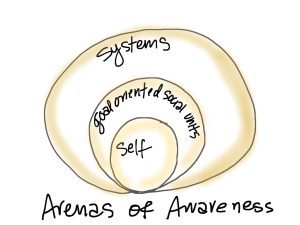Some pundits proclaim that leadership rests on charisma, the ability to create a vision, or “presence.” Teams do need a vision and a compelling goal. But do teams need one charismatic leader? No.Teams need leaders of a different sort. Teams need leaders who don’t need to be out in front, who are able to work quietly, creating an environment where everyone on the team is empowered. Such leaders–empowering leaders—may not get the glory. They do help teams get work done, invite creativity, and build capacity. How do they work? Not by rousing speeches, through followers or by exuding some magical stuff. Empowering leaders create an environment where everyone is empowered. The act on observation, not gut feel or random action.
As Yogi Berra pointed out, you can observe a lot just by watching. But what should you watch? How do you make meaning of what you see?
We are bombarded with sensory input, and our brains are built to find patterns. They are also build to filter out data. Empowering leaders can’t rely on innate observation abilities. They need to hone their awareness to make their interpretations reliable guides for action. Empowering leaders hone awareness in three areas:
- Self-awareness. They know their own strengths, patterns, blind spots.
- Team Awareness. They understand group dynamics and understand that teams are goal oriented social units.
- System Awareness. They grasp that the team exists within a larger system, which includes the organization as a whole, other teams, customers, work flows, and policies.
 The average person knows quite a bit about him or herself. He knows what he likes, and what he doesn’t like. He probably knows whether he likes to decide quickly, shoot from the hip, or examine all the options before choosing. He probably knows whether he is mad, sad or glad at any given moment. He probably thinks he knows what he’s good at.
The average person knows quite a bit about him or herself. He knows what he likes, and what he doesn’t like. He probably knows whether he likes to decide quickly, shoot from the hip, or examine all the options before choosing. He probably knows whether he is mad, sad or glad at any given moment. He probably thinks he knows what he’s good at.
Average self-knowledge isn’t good enough for leaders. Empowering leaders observe their own thoughts and feelings, so they can manage their emotional responses. They separate the data from the interpretations they make of data. They understand their thought patterns, and how they respond to stress. They understand how that not everyone sees the world the same way (and that’s a good thing).
Empowering leaders learn to observe the team and discern patterns of behavior on the group level that effect that ability of the group to get work done. They notice who offers ideas, who challenges ideas. They notice when one person consistently interrupts another team member. Leaders hone their ability to notice the roles people take in group discussions, and pick up on non-verbal cues. This is the information that allows them to determine what is happening, and what (if anything) is needed to adjust the environment so everyone is empowered and able to work. Empowering leaders notice how the physical arrangements affect work, how information is flowing (or not), and when the constraints on the team are too few or too many.
Finally, empowering leaders pay attention to the context, the world the team works in. How does work flow into the team? What are the relationships with other parts of the organization? Are their policies and procedure that are hindering the team? An empowering leader on a team may not be able to eliminate such factors himself. But he knows how modify the team environment to lessen harm, and to influence out side the team to achieve change.
Awareness gives leaders the ability to make sense of the data. Then, they can choose from a variety of responses that will influence the environment to empower all members of the team to contribute.









Great post! One thing I feel should be pointed out on this as well is that empowering leaders are patient. They may see a lot of different “responses that will influence the environment,” but they do not dump everything out of their bucket at once onto the team. They work to make sure the team is comfortable with the first influential change that was introduced and observe again to see what difference this made and how this change might re-prioritize which response they want to choose next to “influence the environment.”
Hi, Rob –
Exactly right.
Dumping changes on a team (or organization) in a rapid fire fashion before the previous change is integrated pretty much guarantees taht all the changes will fail.
Thanks for stopping by and commenting.
e
Awesome!!
Your posts describe a world I would love to live in. And I don’t mean it’s fictitious, it is right, the way it should be. I’ve found less than 10% of those leaders in the wild. Leadership is directly related to power and most human embrace power with self-righteousness.
I firmly believe as humankind evolves we’ll become more empathetic and we’ll appreciate and nurture the equality among ourselves. The world of today is still a selfish cutthroat race to the top. Your words, however, always give me hope in the mornings.
Thank you for that
Mike